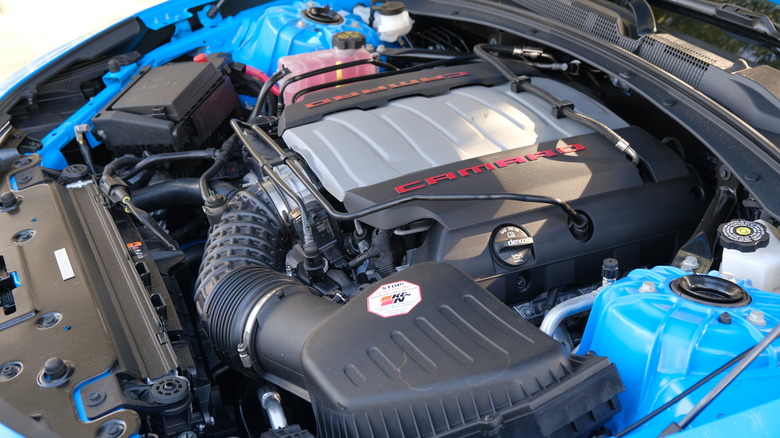GM LT1 Vs. LT4 Engine: What's The Difference?
General Motors has been producing small block V6 and V8 engines since the mid-1950s, and over the last 70 years of their existence, they have been through a great number of changes. The biggest shift came in 1997 with the introduction of the LS family of small block engines, which continue to be what GM uses to this day. There have been a total of three generations of the LS engines, with the current one starting back in 2013. These 90-degree V6 and V8 engines power vehicles ranging from the Chevrolet Corvette to the Cadillac Escalade-V. Typically, these are pretty high-performance engines, and two of the most powerful ever made by General Motors are the LT1 and LT4 engines.
At a first glance, these engines look to be incredibly similar, and they are. Both are 90-degree overhead valve small block V8 engines with 6.2L of displacement. Each is built utilizing cast aluminum engine blocks and cylinder heads. The similarities between the LT1 and LT4 start to dry up there, as the two V8 engines have quite different lives when underneath the hood of a car. With subtle differences here and there — along with the help of a supercharger — one of these engines ends up being far more powerful than its sister model.
It's all about performance
The LT4 is essentially a higher performance version of the LT1, which was already an engine designed for performance and sports cars like the Chevrolet Corvette Stingray. Depending on which vehicle it is in, the LT1 is able to generate 455 to 460 hp and 455 to 465 lb-ft of torque. For a passenger vehicle, that is quite a lot of oomph, but when put up against the LT4, those numbers pale in comparison. That V8 engine has a power output of 650 hp and 650 lb-ft of torque for most vehicles, and that even goes up to 682 hp and 653 lb-ft of torque in a Cadillac Escalade-V.
As for how there is such a dramatic increase in power, it mostly comes down to the 1.7L Eaton R1740 TS supercharger found in the LT4. This is able to spin up to 20,000 RPM and shrinks the compression ratio from the LT1's 11.5:1 to 10:1. A supercharger is able to increase an engine's power capabilities by compressing the air that goes into the combustion chamber for more pressure, which is why the compression ratio isn't as wide. Most car companies nowadays utilize turbochargers for their performance engines, which increase power through using exhaust gas, but a supercharger works directly from the engine's mechanics.
Outside of their power outputs and where they are manufactured — the LT1 in Tonawanda, NY and the LT4 in St. Catherine's, Ontario — the two V8 engines have mostly everything else in common. They are both part of the General Motors LS small block engine family, after all.
[Image by Dcmaradiaga via Wikimedia Commons | Cropped and scaled | CC BY-SA 4.0]

